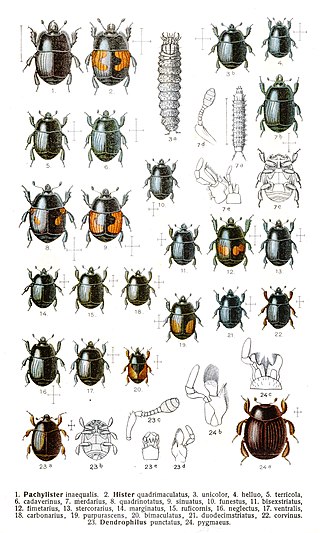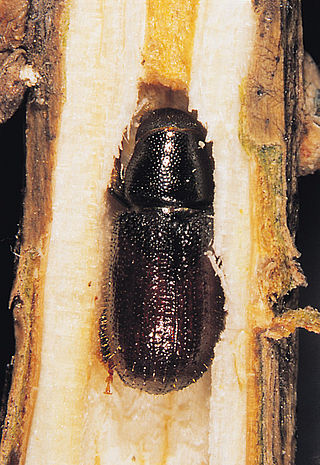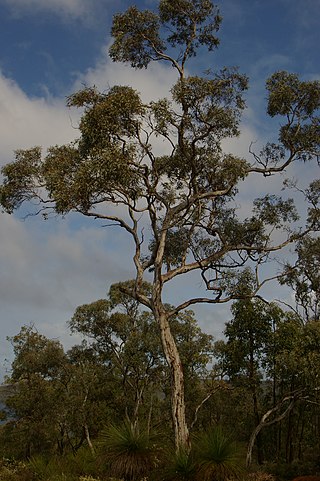
Eucalyptus is a genus of over seven hundred species of flowering trees, shrubs or mallees in the myrtle family, Myrtaceae. Along with several other genera in the tribe Eucalypteae, including Corymbia, they are commonly known as eucalypts. Plants in the genus Eucalyptus have bark that is either smooth, fibrous, hard or stringy, leaves with oil glands, and sepals and petals that are fused to form a "cap" or operculum over the stamens. The fruit is a woody capsule commonly referred to as a "gumnut".

Histeridae is a family of beetles commonly known as clown beetles or hister beetles. This very diverse group of beetles contains 3,900 species found worldwide. They can be easily identified by their shortened elytra that leaves two of the seven tergites exposed, and their geniculate (elbowed) antennae with clubbed ends. These predatory feeders are most active at night and will fake death if they feel threatened. This family of beetles will occupy almost any kind of niche throughout the world. Hister beetles have proved useful during forensic investigations to help in time of death estimation. Also, certain species are used in the control of livestock pests that infest dung and to control houseflies. Because they are predacious and will even eat other hister beetles, they must be isolated when collected.

A bark beetle is the common name for the subfamily of beetles Scolytinae. Previously, this was considered a distinct family (Scolytidae), but is now understood to be a specialized clade of the "true weevil" family (Curculionidae). Although the term "bark beetle" refers to the fact that many species feed in the inner bark (phloem) layer of trees, the subfamily also has many species with other lifestyles, including some that bore into wood, feed in fruit and seeds, or tunnel into herbaceous plants. Well-known species are members of the type genus Scolytus, namely the European elm bark beetle S. multistriatus and the large elm bark beetle S. scolytus, which like the American elm bark beetle Hylurgopinus rufipes, transmit Dutch elm disease fungi (Ophiostoma). The mountain pine beetle Dendroctonus ponderosae, southern pine beetle Dendroctonus frontalis, and their near relatives are major pests of conifer forests in North America. A similarly aggressive species in Europe is the spruce ips Ips typographus. A tiny bark beetle, the coffee berry borer, Hypothenemus hampei is a major pest on coffee plantations around the world.

The Tenebrionoidea are a very large and diverse superfamily of beetles. It generally corresponds to the Heteromera of earlier authors.

Coccinella septempunctata, the seven-spot ladybird, is the most common ladybird in Europe. Its elytra are of a red colour, but punctuated with three black spots each, with one further spot being spread over the junction of the two, making a total of seven spots, from which the species derives both its common and scientific names.

Colydiinae is a subfamily of beetles, commonly known as cylindrical bark beetles. They have been treated historically as a family Colydiidae, but have been moved into the Zopheridae, where they constitute the bulk of the diversity of the newly expanded family, with about 140 genera worldwide. They are diverse for example in the Australian region, from where about 35 genera are known; in Europe, though, only 20 genera are found and many of these only with few species.

Cleridae are a family of beetles of the superfamily Cleroidea. They are commonly known as checkered beetles. The family Cleridae has a worldwide distribution, and a variety of habitats and feeding preferences.

Tomicus piniperda, the common pine shoot beetle, is a bark beetle native throughout Europe, northwestern Africa, and northern Asia. It is one of the most destructive shoot-feeding species in northern Europe.

Eucalyptus wandoo, commonly known as wandoo, dooto, warrnt or wornt and sometimes as white gum is a small to medium-sized tree that is endemic to the southwest of Western Australia. It has smooth bark, lance-shaped adult leaves, flower buds in groups of nine to seventeen, white flowers and conical to cylindrical fruit. It is one of a number of similar Eucalyptus species known as wandoo.

Rhizophora mucronata is a species of mangrove found on coasts and river banks in East Africa and the Indo-Pacific region.

Ips is a genus of beetles in the family Curculionidae, the true weevils. They are bark beetles, members of the subfamily Scolytinae. Species are distributed throughout the Northern Hemisphere. Some are known as introduced species in Australia and Africa. Many species are pests of forest trees, especially pines and spruces. They are known commonly as engraver beetles, ips engraver beetles, and pine engravers.

Microprius is a genus of cylindrical bark beetles in the family Zopheridae. There are at least two described species in Microprius.
Cebia rugosa is a species of cylindrical bark beetle native to India and Sri Lanka.
Silvanoprus cephalotes, is a species of silvan flat bark beetle found with a widespread distribution across Oriental and Papuan regions and also in the Palaearctic Far East.
Silvanus lewisi, sometimes known as Asian silvanid beetle, is a species of silvan flat bark beetle found throughout Oriental region and introduced to many parts of the world.
Silvanus recticollis, is a species of silvan flat bark beetle found in Afro-Oriental regions.
Xylotrupes meridionalis, commonly known as forked horns rhinoceros beetle, is a species of rhinoceros beetle found in India and Sri Lanka.

Herophydrus musicus, is a species of predaceous diving beetle found in Asia and Europe.
Xyleborinus exiguus, is a species of weevil widely distributed throughout the Old World tropics and introduced to African and South American countries.
Xyleborus perforans, commonly known as island pinhole borer, is a species of weevil native in the Oriental region through to Australia but shows a cosmopolitan distribution due to introduction to many parts of the world.













